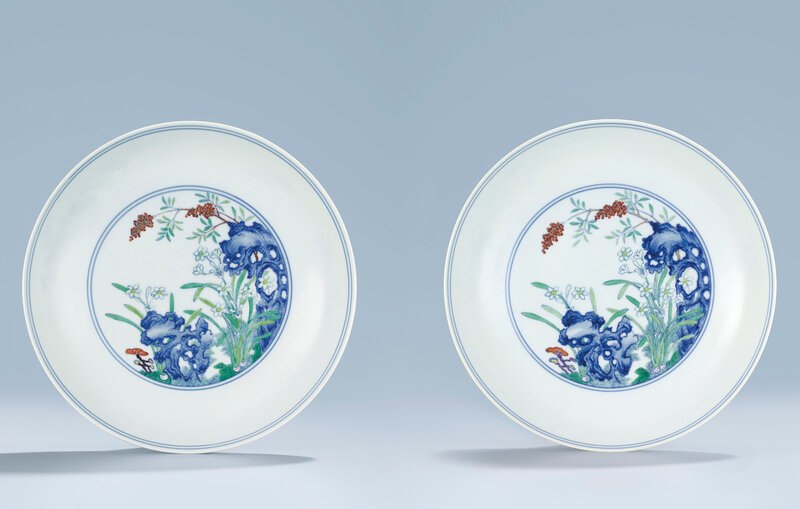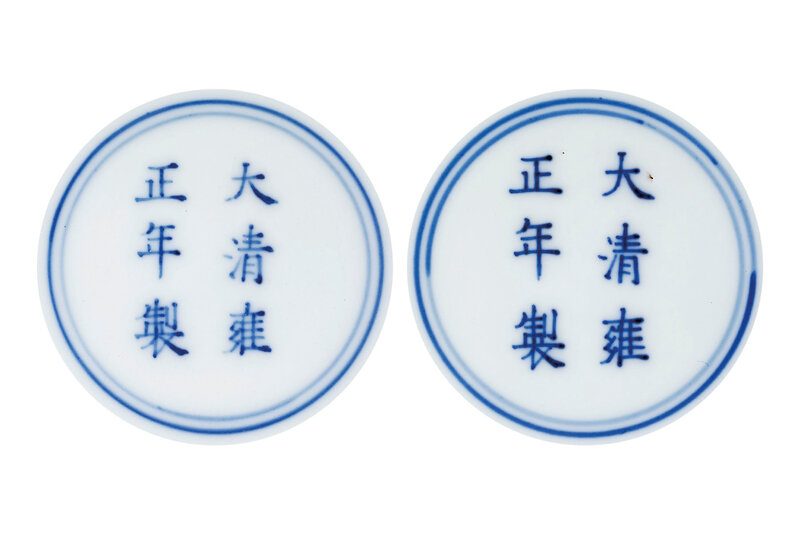A fine and rare pair of doucai 'Narcissus' dishes , Yongzheng six-character marks within double circles and of the period
Lot 2911. A fine and rare pair of doucai 'Narcissus' dishes , Yongzheng six-character marks within double circles and of the period (1723-1735); 8 1/8 in. (20.6 cm.) diam. Estimate HK$4,800,000 - HK$5,800,000 ($621,949 - $751,522). Price Realized HK$7,240,000 ($937,888). © Christie's Image Ltd 2014
Each dish is well potted with thin, gently rounded sides, exquisitely pencilled and enamelled to the central medallion on the interior with narcissus plants growing beside pierced ornamental rocks, lingzhi shrubs and branches bearing nandina berries. The exterior is decorated with three similar detached groups of narcissus, plants and rocks.
Provenance: A Hong Kong private collection
Sold at Sotheby's Hong Kong, 29 April 1992, lot 214
Sold at Sotheby's Hong Kong, 26 October 2003, lot 8
Note: The current dishes are exquisite example of doucai wares from the Yongzheng reign and are exceptionally fine. The decoration on this dish is not only beautiful, it was also chosen to convey an auspicious meaning suitable for a birthday. Both the interior and the exterior are decorated with narcissus, nandina, lingzhi fungus, with ornamental rocks. Narcissus is associated in China with good fortune and prosperity, and is often displayed at the New Year. However, its Chinese name translates as 'water immortal flower', and in this design combines with the lingzhi (the fungus of immortality) to suggest the 'fungus immortal'. The name of the nandina plant and the phrase for rocks in Chinese combine with the narcissus and lingzhi, to provide a rebus for either 'May the immortals congratulate you on your birthday' or 'May the immortals bestow long life upon you'.
It is highly probable that the design was inspired from a garden view outside the emperor's studio. One of the album paintings Shuzhai xiejing, 'Copying Sutras in the Studio', in the album leave series entitled Yongzheng xingle tu, 'Emperor Yongzheng at Play', in the collection of the Palace Museum, Beijing, depicts the emperor in a Han-style costume seating by his desk while overlooking plants of narcissus and nandina growing amidst rocks. All sixteen from this album are illustrated in Paintings by the Court Artists of the Qing Court, The Complete Collection of Treasures of the Palace Museum, vol. 14, Hong Kong, 1996, pp. 106-111, figs. 16.1-16.16. The scene is very similar to the decoration on the present lot. It must have been a favourite scene of the emperor's for him to have commissioned a court painter to represent it on paper which the imperial kiln potters would then have rendered onto porcelain.
Similar examples include one exhibited at The Hundred Flowers. Botanical Motifs in Chinese Art, Asian Art Museum of San Francisco, 1985, Catalogue, no. 46; one illustrated in Mayuyama, Seventy Years , vol. I, Tokyo, 1976, p. 335, no. 1065; and another from the Chang Foundation, Taipei, is included by James Spencer, Selected Chinese Ceramics from Han to Qing Dynasties, Taipei, 1990, pl. 137. Examples previously sold at auction include one sold at Christie's Hong Kong, 30 November 2011, lot 2933; and from the Meiyintang Collection and sold at Sotheby's Hong Kong 5 October 2011, lot 29.
Christie's. Imperial Chinese Treasures from a Distinguished American Collection, Hong Kong, 28 May 2014

/https%3A%2F%2Fprofilepics.canalblog.com%2Fprofilepics%2F1%2F0%2F100183.jpg)
/https%3A%2F%2Fstorage.canalblog.com%2F03%2F02%2F119589%2F96711876_o.jpg)
/https%3A%2F%2Fstorage.canalblog.com%2F11%2F31%2F119589%2F94773502_o.jpg)
/https%3A%2F%2Fstorage.canalblog.com%2F20%2F83%2F119589%2F94772815_o.jpg)
/https%3A%2F%2Fstorage.canalblog.com%2F26%2F72%2F119589%2F75604929_o.jpg)
/https%3A%2F%2Fstorage.canalblog.com%2F59%2F60%2F119589%2F26458628_o.jpg)





/image%2F1371349%2F20240326%2Fob_936d86_104-1.jpg)
/image%2F1371349%2F20240326%2Fob_823710_102-1.jpg)
/image%2F1371349%2F20240326%2Fob_55a293_101-1.jpg)
/http%3A%2F%2Fstorage.canalblog.com%2F33%2F99%2F119589%2F129627838_o.jpg)